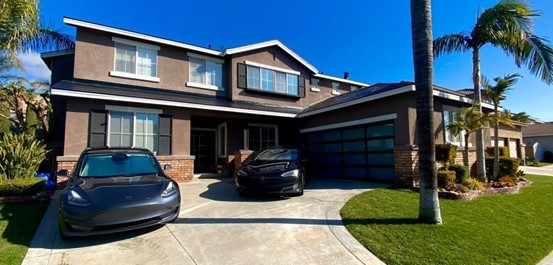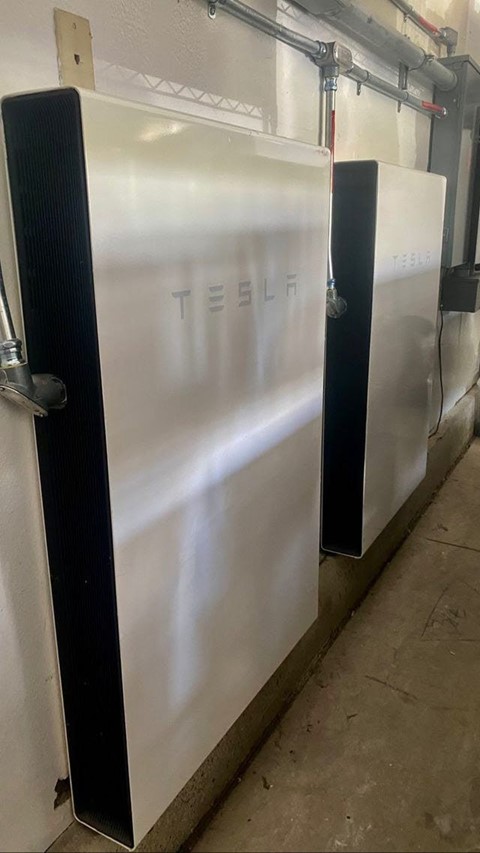Richard and Beth Parrish Got Lucky
Richard and Beth Parrish Got Lucky 3-16-2022
As the current average price for gas in the U.S. reaches $4.98 per gallon — nearly double this time last year — the couple’s clean energy improvements are paying dividends. As the general public pays extortionate prices for gas, the couple runs their cars on sunshine.
“It’s not to be boastful,” Richard says. “We feel for them, but we’re not affected by that now,” Richard says.
Last year, the couple put the final touch on their Teslafied home in Rancho Cucamonga, California: a Tesla Solar Roof. It’s paired with two Tesla Powerwall home batteries — “enough to run the house for three to five days” — and two electric cars: a 210-mile-range Model S and a 320-mile- range Model 3.
“There’s no more gas stations,” Richard says. “There’s no more messing about.” Just plug in the car, receive power from the home batteries, and top up the batteries using sunshine.

It bears resemblance to Elon Musk’s 2016 “house of the future,” unveiled in the same year that Tesla merged with solar energy company SolarCity, which was founded by Musk’s cousins, Peter and Lyndon Rive.
The roof measures 2,747 square feet and has a capacity to generate 14.5 kilowatts of energy. Each Powerwall battery has the capacity to store 13.5 kilowatt-hours of power.
The couple says it’s already become a feature of the neighborhood.
“Somebody actually knocked on the door and said, ‘Excuse me, I’m so sorry to interrupt, but is that a Tesla roof?’” Richard says. “We spent 30 minutes talking to him about the roof and he went on his way. He said, ‘I’ve driven around the whole neighborhood looking for it, I heard it was here!’”
Tesla even shared the house on its official Twitter page, which led to a wide range of responses.
Solar Roof lets you become your own renewable energy utility. Generate clean energy and drive on solar. 📸📸: @BethlyP on IG 3,335 Retweets29,656 Likes
As we talk on a Thursday morning, Beth sends me a screenshot of the Tesla smartphone app. Her roof has already generated 16.2 kilowatt-hours of energy so far in the day, enough to power a 900-watt microwave for 18 hours.
Tesla Solar Roof: How it came together
The obsession started when the couple went on a road trip with a friend in 2016, who let them borrow one of their Tesla vehicles. They were amazed at how easy it was, even then, to charge the car and continue driving.
Within three months, they’d ordered their own. They then put a deposit down for the Solar Roof.
- December 2019: Tesla called and declared the couple would be up and running in February 2020. This came as Tesla announced its third-generation tiles to speed up rollouts. Unfortunately, the Covid-19 pandemic meant it would take almost another year before Tesla got back in touch.
- September 2020: Tesla started arranging permits.
- December 2020: Tesla inspected the house
- January 2021: Work started with a team of 16 workers on the roof. Richard was impressed by the roofing membrane, which he said was about a quarter-inch thick and “five times thicker than any roofing product I’d ever seen.”
- March 2021: Connected! The roof itself was completed over a two-week period, but the couple only got connected by the middle of March.
The setup turned out to be ideal. The couple owns a company that supplies specialty chemicals to the textile industry, meaning they drive over 75,000 miles per year in California making deliveries. When higher gas prices hit, it could have devastated their business.

Tesla Solar Roof: Pricing
This is the big question. Musk has stated on several occasions that the company’s goal is to bring the Tesla Solar Roof price down to the cost of a traditional roof plus solar panels.
Here’s how the costs broke down for Richard and Beth Parrish:
- The roof cost $60,555.77
- The solar portion alone costs $41,326.60 — more later on why this distinction matters
- The two Powerwall batteries cost $13,000
- A backup gateway to connect to the grid cost $1,100
- It cost $2,500 to install the Powerwall…
- …but the couple also got a $2,575 discount for getting the Solar Roof and Powerwall at the same time
- Pre-construction preparation costs came to $10,812
- That included permitting and roof preparation for $5,434
- Electrical upgrades came to $5,378
All of this added up to a total system price of $85,392.77. The taxes came to $1,092.75, which means a contract price of $86,485.52.
Compared to the cost of installing a regular roof plus solar panels, it’s a bit higher.
- Beth and Richard estimate a new roof would have cost $35,000
- Solar panels on top of the roof would have cost $34,000. The couple had SolarCity come and evaluate the roof, who recommended a system of 31 panels.
- As mentioned above, Beth and Richard needed to pay around $5,000 to upgrade the home electrics
- That means the two bought separately would have likely cost around $74,000
“We just didn’t see the benefit of the outward appearance of it for the money savings,” Richard says.
But there’s another sweetener. The federal government gives 26 percent tax credit for solar installations completed before the end of 2022. While that would mean a tax credit of around $9,000 for the two separated, the fact that the solar portion is more expensive means the couple got a bigger tax credit.
The tax credit also covers the Powerwall batteries. That means in total the tax credit savings came to around $16,000 (note that the tax credit is only useful if you actually owe more tax than that in a given year, as this particular credit is non-refundable).

Tesla Solar Roof: How long it will take to pay off
Beth and Richard were heavy electricity users. Their monthly bills sometimes came to over $1,000, and never dropped below $200.
“The power company sent us notices,” Richard says. “Hey, you’re a gross negligent user here. What are you doing?”
They explain they had four kids living with them, who have all since left home. They also had a pool, jacuzzi, air conditioning on all the time, and flat-screen TVs.
So when will they start earning money? The couple is paying off the roof in $1,100 monthly installments, so it should be paid off in around seven years. But the couple says they could have chosen to pay it off with monthly bills equivalent to the old electricity bill.
The couple will still have to pay around $50 per year to stay connected to the grid, but they also earn back a small amount for the energy they give to the grid. That means, in around seven years, they should start receiving free electricity.
“It should power our house for the next 30 years cleanly, quietly, and without us having to do anything,” Richard says.
This isn’t the end of their Tesla journey either. The couple has also got a Tesla Cybertruck on order — though whether it arrives before or after they’re finished paying off their solar roof remains to be seen.
